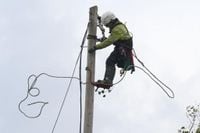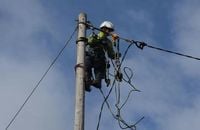As dawn broke on Sunday, October 5, 2025, the aftermath of Storm Amy was still being felt by thousands across Ireland and Northern Ireland. For many, the hum of electricity had yet to return—3,000 properties in Northern Ireland and 13,000 in the Republic of Ireland remained without power, according to NIE Networks and the Electricity Supply Board (ESB). Yet, compared to the storm’s peak, when hundreds of thousands were plunged into darkness, these numbers signaled remarkable progress in the face of one of the fiercest weather events to hit the island in recent memory.
Storm Amy arrived with a vengeance late last week, battering the west and north-west of Ireland with gusts reaching up to 148 km/h (91 mph) and sustained winds of 94 km/h (59 mph) in the most exposed coastal areas, as reported by Met Éireann. The system’s impact was swift and widespread: trees toppled, roads flooded, schools closed, and at one point, approximately 65,000 customers in Northern Ireland alone lost power, according to NIE Networks. South of the border, the ESB and NIE Networks together counted hundreds of thousands without electricity at the storm’s height.
The storm’s human toll was tragically underscored by the death of Tommy Connors, who was seriously injured in the Letterkenny area of County Donegal shortly after 4:15 pm on Friday, October 3. According to An Garda Síochána, the incident was weather-related. Mr. Connors was taken to Letterkenny University Hospital, where a post-mortem examination is to be carried out. His death cast a somber shadow over the recovery efforts, reminding everyone of the storm’s real dangers beyond infrastructural damage.
As the weekend progressed, the scale of the challenge became clear. By Saturday night, October 4, the number of properties without power had dropped to about 11,000 in the Republic of Ireland and 9,000 in Northern Ireland, according to official updates cited by BBC and other outlets. Yet, for those still waiting, the frustration was palpable. Mark Lennon, an ESB network technician working in Balbriggan, Co Dublin, told the PA news agency, “It hasn’t been so bad. Weather-wise it has been a bit rough and the winds are still picking up a bit—but we’re getting there. Everyone should be back on by tomorrow.” He praised the patience of those affected and offered a crucial reminder: “If you see lines down, completely stay clear and ring our emergency number 1800 372 999, and we’ll respond 24/7.”
Alex Houston, operations manager for NIE Networks, echoed the determination of restoration crews. “We are doing our very best to get as many as possible reconnected today,” he said on Sunday. Houston urged anyone still without power—and who hadn’t yet reported it—to call the customer centre at 03457 643 643. “At this stage we would encourage anyone who has not yet reported their power cut to contact the customer centre…so we can ensure all faults are reported and in the restoration process.” His message was clear: every report mattered, and every effort was being made to bring the lights back on.
By Sunday morning, the worst of the weather appeared to have passed. All inland weather warnings, including status orange and yellow wind and rain warnings for Donegal, Leitrim, Sligo, Dublin, Louth, Wicklow, Clare, Kerry, Galway, and Mayo, had lapsed by midday Saturday, according to Met Éireann. In Northern Ireland, yellow-level rain and wind warnings also expired—rain at noon and wind at midnight on Saturday—giving repair crews a much-needed window of safer conditions to accelerate their work. The Police Service of Northern Ireland (PSNI) nonetheless urged continued caution, reminding road users of the lingering risks: “Surface water, flooding, fallen debris or temporary restrictions are all a strong possibility.”
Despite the improving weather, the road to full recovery was expected to take a little longer. The ESB warned that it could be “the early part of next week” before all customers in the Republic of Ireland are reconnected, a timeline echoed by NIE Networks, which projected that restoration in Northern Ireland could be completed by Monday evening, October 6, at the latest. The areas hit hardest in the Republic included counties Donegal, Leitrim, Roscommon, Galway, and Mayo, where damage to infrastructure was most severe.
For many, Storm Amy was a stark reminder of the island’s vulnerability to extreme weather. Local authorities and emergency services worked around the clock to clear fallen trees, restore transport links, and respond to emergencies. In one notable callout, ESB crews in Balbriggan, Co Dublin, dealt with a fallen ash tree that had brought down a power line—a scene repeated in dozens of communities across the island. The PSNI highlighted the coordinated response: “Storm Amy clean-up operations will be intensifying this morning as multiple agencies work to restore the power, water and transport networks for all users across Northern Ireland.”
The public response was, for the most part, patient and understanding. “Everyone we have been dealing with so far has been very patient, they understand it’s been challenging,” said Mark Lennon. That patience, coupled with the tireless work of repair crews, was instrumental in the rapid progress made since the storm’s peak. The lifting of all inland weather warnings by Sunday underscored the improving situation, giving a much-needed boost to those still waiting for normalcy to return.
Yet, the story of Storm Amy is not just one of disruption and repair—it is also a testament to the resilience and solidarity of communities across Ireland. From the emergency responders risking their safety to restore essential services, to neighbors checking on one another in the darkness, the collective effort was unmistakable. As the ESB and NIE Networks worked through the final outages, the hope was that by early next week, every home and business would once again be connected, and life could resume its familiar rhythm.
In the end, while the storm left scars—both physical and emotional—it also revealed the strength of a community united in adversity. As the last homes flicker back to life, the island can look back on a weekend that tested its resolve and found it unbroken.





